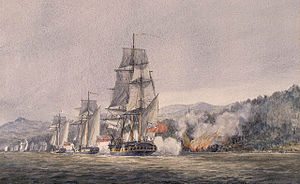
Back Seegefecht bei Valcour Island German Batalla de la isla Valcour Spanish Valcour Islandin taistelu Finnish Bataille de l'île Valcour French Battaglia di Valcour Bay Italian バルカー島の戦い Japanese 발쿠르섬 전투 Korean Slag bij Valcour Island Dutch Slaget ved Valcour Island NB Bitwa koło wyspy Valcour Polish
| Battle of Valcour Island | |||||||
|---|---|---|---|---|---|---|---|
| Part of the American Revolutionary War | |||||||
 Battle of Valcour Island, Unknown artist | |||||||
| |||||||
| Belligerents | |||||||
|
|
| ||||||
| Commanders and leaders | |||||||
|
|
| ||||||
| Strength | |||||||
|
1 sloop 2 schooners 1 radeau 1 gundalow 28 gunboats[3][4][5] |
4 galleys 2 schooners 1 sloop 8 gundalows[6][Note 1] | ||||||
| Casualties and losses | |||||||
|
40 killed or wounded[7] 1 gunboat destroyed 2 gunboats sunk |
80 killed or wounded 120 captured 1 schooner destroyed 1 galley destroyed 2 galleys captured 3 gundalows destroyed 3 gundalows sunk 1 gundalow captured[8] | ||||||
The Battle of Valcour Island, also known as the Battle of Valcour Bay, was a naval engagement that took place on October 11, 1776, on Lake Champlain. The main action took place in Valcour Bay, a narrow strait between the New York mainland and Valcour Island. The battle is generally regarded as one of the first naval battles of the American Revolutionary War, and one of the first fought by the United States Navy. Most of the ships in the American fleet under the command of Benedict Arnold were captured or destroyed by a British force under the overall direction of General Guy Carleton. However, the American defense of Lake Champlain stalled British plans to reach the upper Hudson River valley.
The Continental Army had retreated from Quebec to Fort Ticonderoga and Fort Crown Point in June 1776 after British forces were massively reinforced. They spent the summer of 1776 fortifying those forts and building additional ships to augment the small American fleet already on the lake. General Carleton had a 9,000 man army at Fort Saint-Jean, but needed to build a fleet to carry it on the lake. The Americans, during their retreat, had either taken or destroyed most of the ships on the lake. By early October, the British fleet, which significantly outgunned the American fleet, was ready for launch.
On October 11, Arnold drew the British fleet to a position he had carefully chosen to limit their advantages. In the battle that followed, many of the American ships were damaged or destroyed. That night, Arnold sneaked the American fleet past the British one, beginning a retreat toward Crown Point and Ticonderoga. Unfavorable weather hampered the American retreat, and more of the fleet was either captured or grounded and burned before it could reach Crown Point. Upon reaching Crown Point Arnold had the fort's buildings burned and retreated to Ticonderoga.
The British fleet included four officers who later became admirals in the Royal Navy: Thomas Pringle, James Dacres, Edward Pellew, and John Schank. Valcour Bay, the site of the battle, is now a National Historic Landmark, as is Philadelphia, which sank shortly after the October 11 battle, and was raised in 1935. The underwater site of Spitfire, located in 1997, is on the National Register of Historic Places.
- ^ Schroeder (2005), p. 12
- ^ Phillips (1999), p. 152
- ^ Hadden, James Murray (1884). Hadden's Journal and Orderly Books. A Journal Kept in Canada and Upon Burgoyne's Campaign in 1776 and 1777 (Reprinted ed.). Albany, NY: Joel Munsell's Sons. p. 22. Retrieved 23 November 2017.
- ^ Bratten (2002), p. 59
- ^ Bratten (2002), p. 58
- ^ Hadden, James Murray (1884). Hadden's Journal and Orderly Books. A Journal Kept in Canada and Upon Burgoyne's Campaign in 1776 and 1777 (Reprinted ed.). Albany, NY: Joel Munsell's Sons. pp. 16, 22. Retrieved 23 November 2017.
- ^ Allen (1913), p. 176
- ^ Miller (1974), p. 178
Cite error: There are <ref group=Note> tags on this page, but the references will not show without a {{reflist|group=Note}} template (see the help page).
© MMXXIII Rich X Search. We shall prevail. All rights reserved. Rich X Search